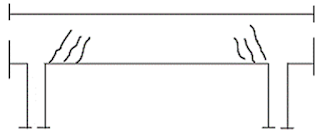TYPES OF CRACKS IN CONCRETE COLUMNS
TYPES
} 1. Cracks due to
eccentricity in concrete columns
} 2. Cracks due to corrosion of reinforcement in concrete columns
} 3. Cracks due to increased column
load
crack due to
eccentricity in concrete columns
Cracks
due to corrosion of reinforcement in concrete columns
Cracks
due to increased column load
TYPES OF CRACKS IN CONCRETE BEAMS
} 1. Cracks in concrete beams due to
increased shear stress
} 2. Cracks in concrete beams due to
corrosion or insufficient concrete cover
} 3. Cracks parallel to main steel in
case of corrosion in beams
} 4. Cracks due to increased bending
stress in beams
} 5. Cracks due to compression failure
in beams
Cracks
in concrete beams due to increased shear stress
Cracks
in concrete beams due to corrosion or insufficient concrete cover
Cracks
parallel to main steel in case of corrosion in beams
Cracks
due to increased bending stress in beams
Cracks
due to compression failure in beams
TYPES OF CRACKS IN
REINFORCED CONCRETE SLABS
} 1. Cracks in reinforced concrete
Slab due to Steel Corrosion (cracks parallel to steel bars)
} 2. Cracks in reinforced concrete
Slab due to shrinkage of concrete
} 3. Cracks in reinforced concrete
Slab due to increased load on the slab
} 4. Cracks in reinforced concrete
slab due to sulphate attack
} 5. Cracks in reinforced concrete
slab due to alkaline aggregates
Cracks
in reinforced concrete slab due to Steel Corrosion (cracks parallel to steel
bars)
Cracks
in reinforced concrete slab due to shrinkage of concrete
Cracks
in reinforced concrete slabs due to increased load on the slab
Cracks
in reinforced concrete slab due to sulphate attack
Cracks
in reinforced concrete slab due to alkaline aggregates
CRACKING IN WALLS
Causes
of cracks in wall
Types of cracks in wall
- EXPANSION CRACKS
- CRACKS ABOVE OPENINGS
- WALL TIE FAILURE
- SUBSIDENCE GROUND HEAVE
1.
EXPANSION CRACKS
} Cause
Walls are affected by
temperature and moisture change. Materials can suffer from initial shrinkage
and/or subsequent expansion and contraction. This movement gives rise to the
cracks.
2. CRACKS
ABOVE OPENINGS
Cause
Four causes are:
◦
(a) Removal of windows or doors with inadequate propping,
◦
(b) Inadequate bearings,
◦
(c) Loads applied directly over the opening,
◦
(d) No lintels.
3. WALL
TIE FAILURE
} Cause
} Wall ties are metal ties that are
built into both solid and cavity walls built in stretcher bond to hold the
outside skin of brickwork to the inside. Failure normally occurs when the ties
rust. When the metal ties rust they expand causing the cracking normally seen
every sixth course horizontally in the mortar joints.
4.
SUBSIDENCE
} Cause
} The worst and most serious type of
cracking and consequently the most difficult to repair.
} Subsidence can occur due to a
variety of reasons:
–
1. Mining activity
–
2. Leaking underground drainage
–
3. Tree root activity
–
4. Peak subsoil
–
5. Clay subsoil
–
6. Running sand
GROUND
HEAVE
} The pattern is similar to subsidence
cracks; however, the crack will be widest at the base of the wall. The most
common cause of ground heave is expansion of clay subsoils. On older properties
with shallow foundations the clay can expand and contract dependent upon the weather
conditions. If the clay becomes waterlogged it can expand and push the
foundations upwards causing the cracks.
} The removal of trees can also cause
ground heave, which is why trees that are too close to the property should be
taken down in stages, slowly over a number of years to allow gradual ground
movement (the problem of trees and tree roots will also be dealt with in a
later article).
















0 comments:
Post a Comment